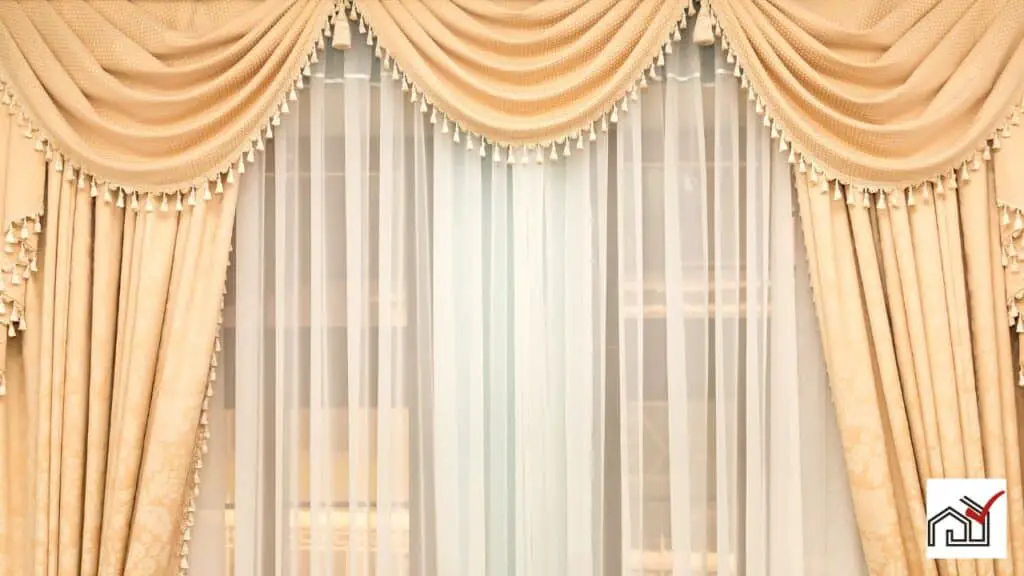A curtain valance is a piece of fabric that hangs at the top of a window to add decoration. It hides the curtain rod and hardware, giving a neat look. Valances come in various styles, materials, and patterns, and can suit different room designs, from classic to modern. They can be paired with curtains or used alone.
Valances can also make windows appear differently sized, contributing to a room’s overall feel. They are commonly used in interior decorating.
Defining Curtain Valance
A curtain valance is a type of window decoration that covers the top part of a window. It is used to hide the curtain rods and add a decorative touch. Valances can be made of fabric and may be used alone or with other window treatments like blinds or curtains.
They come in various styles, colors, and patterns and can influence the feel of a room, ranging from simple to ornate designs. Valances not only serve a decorative purpose but also cover the upper part of a window that might show hardware or flaws.
When choosing a valance, it’s important to consider the room’s existing decor for a cohesive look. The right valance should match the room’s style and enhance the window treatment setup.
A curtain valance is a functional and stylish item for interior design.
Historical Significance
Valances have been a key component of window decoration since the Renaissance, marking changes in design preferences over time. Initially, their purpose was practical, hiding the fixtures for hanging curtains. Over time, as interior design grew more complex, valances became decorative, reflecting the style of the period.
In the Baroque era, valances became more elaborate, aligning with the period’s love for lavishness. During the early Georgian period, valances were integrated into building architecture, enhancing window framing and indicating the homeowner’s wealth and attention to detail.
The Victorian era saw valances become common in window decor, often layered and detailed, signaling their role in the progression of interior design from functional to ornamental and fashionable.
Valances have varied in design, including different shapes like scalloped or arched hems, showing their long-standing decorative function. They have evolved with each design movement, acting as a record of the evolving preferences and values related to window decor.
Their versatility and visual appeal have secured their place in interior design history, demonstrating their ongoing importance.
Different Styles Explored
Curtain valances come in various styles to match different interior designs. These styles range from simple straight gathered valances to elaborate ones like Italian and Ascot valances. Valances serve to hide the curtain hardware at the top of the window and add a decorative element to the room.
Balloon valances create a soft and inviting atmosphere with their puffed fabric, usually lightweight cotton. Swag valances have a fluid look, draped over brackets to form an elegant line across the window, with ends that hang down for added drama. Sheer fabrics are often used in this style, known as scarf valances.
Ascot valances lend a formal look to a space with their rich fabrics, such as silk or velvet, and often feature details like tassels or fringes. They have a distinctive triangular shape.
Italian valances have a curved design that narrows at the center, adding architectural interest and elegance to a room.
Valances are adaptable decor elements that can enhance the aesthetics of any interior.
Installation and Maintenance
For proper installation of curtain valances, precise measurements and careful hanging are critical. Choose curtain rods with a diameter less than half of the rod pocket diameter for a tight fit, ideally not exceeding 1-5/8 inches. An outside-mounted valance, particularly board-mounted styles, is recommended for ease of installation and aesthetic appeal. Installing valances higher can make the room appear larger and taller.
Maintenance is key to keeping valances in good condition. They are usually out of reach of children and pets, minimizing safety risks. Regular dusting or vacuuming is necessary. For custom valances, follow the specific care instructions provided by the manufacturer.
Proper installation and maintenance prolong the valance’s life and ensure it remains an effective part of your interior design.
Functional Benefits
Curtain valances have functional advantages beyond their decorative role. They increase privacy by covering the top of windows and blocking outside views. Valances help reduce air leaks, contributing to stable indoor temperatures and possible energy cost savings.
Valances can create the impression of higher ceilings by drawing attention upwards, making rooms feel larger. They unify a room’s decor by serving as a focal point. For homes with children and pets, valances are practical; their high placement prevents easy pulling, enhancing safety and longevity. They are also easy to clean, reducing dust and improving air quality.
Decorative Applications
A curtain valance adds visual interest to a room and hides the hardware of window blinds or shades. It can be shaped in various ways, such as arches or straight lines, to match the room’s decor.
Valances vary in color, fabric, and pattern, creating texture and depth. When used with curtains, they provide a sophisticated look. Matching valances with other room fabrics, like pillows, can unify a room’s design.
Valances are a versatile decorative option for enhancing a room’s appearance.





